Understanding the Dynamics of PM2.5 Concentration Levels in China: A Comprehensive Study of Spatio-Temporal Patterns, Driving Factors, and Implications for Environmental Sustainability
Abstract
1. Introduction
2. Data Sources and Research Methods
2.1. Overview of the Study Area
2.2. Data Source
2.2.1. PM2.5 and Other Pollutant Data
2.2.2. Meteorological Data
2.2.3. Social and Economic Data
2.2.4. Land Use and Cover Change and Normalized Difference Vegetation Index Data
2.3. Research Methods
2.3.1. Sen’s Slope Estimation
2.3.2. Spatial Autocorrelation Analysis
2.3.3. GeoDetector
2.3.4. Generalized Additive Model (GAM)
3. Results and Discussion
3.1. Spatio-Temporal Characteristics of PM2.5
3.1.1. Temporal Variations Characteristics
3.1.2. Spatial Distribution Characteristics
3.2. Spatial Clustering Characteristics
3.3. Detection of Six Regional Impact Factors
3.4. The Influence Mechanism of Driving Factors
3.4.1. Nonlinear Response Mechanism of Driving Factors
3.4.2. The Influence Mechanism of Land Use Types
4. Conclusions
Supplementary Materials
Author Contributions
Funding
Institutional Review Board Statement
Informed Consent Statement
Data Availability Statement
Conflicts of Interest
References
- Li, C. Reversal of trends in global fine particulate matter air pollution. Nat. Commun. 2023, 14, 5349. [Google Scholar] [CrossRef]
- Li, Z.; Liu, Q.; Chen, L.; Zhou, L.; Qi, W.; Wang, C.; Zhang, Y.; Tao, B.; Zhu, L.; Martinez, L.; et al. Ambient air pollution contributed to pulmonary tuberculosis in China. Emerg. Microbes Infect. 2024, 13, 2399275. [Google Scholar] [CrossRef]
- Hoek, G.; Krishnan, R.M.; Beelen, R.; Peters, A.; Ostro, B.; Brunekreef, B.; Kaufman, J.D. Long-term air pollution exposure and cardio-respiratory mortality: A review. Environ. Health 2013, 12, 43. [Google Scholar] [CrossRef] [PubMed]
- Guo, C. Effect of long-term exposure to fine particulate matter on lung function decline and risk of chronic obstructive pulmonary disease in Taiwan: A longitudinal, cohort study. Lancet Planet. Health 2018, 2, e114–e125. [Google Scholar] [CrossRef]
- Yao, P.-T.; Peng, X.; Cao, L.-M.; Zeng, L.-W.; Feng, N.; He, L.-Y.; Huang, X.-F. Evaluation of a new real-time source apportionment system of PM2.5 and its implication on rapid aging of vehicle exhaust. Sci. Total Environ. 2024, 937, 173449. [Google Scholar] [CrossRef] [PubMed]
- Liu, H. The impacts of regional transport on anthropogenic source contributions of PM2.5 in a basin city, China. Sci. Total Environ. 2024, 917, 170038. [Google Scholar] [CrossRef] [PubMed]
- Yang, H.; Yao, R.; Sun, P.; Ge, C.; Ma, Z.; Bian, Y.; Liu, R. Spatiotemporal Evolution and Driving Forces of PM2.5 in Urban Agglomerations in China. Int. J. Environ. Res. Public Health 2023, 20, 2316. [Google Scholar] [CrossRef]
- She, Y.; Chen, Q.; Ye, S.; Wang, P.; Wu, B.; Zhang, S. Spatial-temporal heterogeneity and driving factors of PM2.5 in China: A natural and socioeconomic perspective. Front. Public Health 2022, 10, 10. [Google Scholar] [CrossRef]
- Liu, B.; Wang, L.; Zhang, L.; Bai, K.; Chen, X.; Zhao, G.; Yin, H.; Chen, N.; Li, R.; Xin, J.; et al. Evaluating urban and nonurban PM2.5 variability under clean air actions in China during 2010–2022 based on a new high-quality dataset. Int. J. Digit. Earth 2024, 17, 2310734. [Google Scholar] [CrossRef]
- Huang, H.; Jiang, P.; Chen, Y. Analysis of the Social and Economic Factors Influencing PM2.5 Emissions at the City Level in China. Sustainability 2023, 15, 16335. [Google Scholar] [CrossRef]
- Wang, Y.; Gao, W.; Wang, S.; Song, T.; Gong, Z.; Ji, D.; Wang, L.; Liu, Z.; Tang, G.; Huo, Y.; et al. Contrasting trends of PM2.5 and surface-ozone concentrations in China from 2013 to 2017. Natl. Sci. Rev. 2020, 7, 1331–1339. [Google Scholar] [CrossRef]
- He, K.; Huo, H.; Zhang, Q. Urban Air Pollution in China: Current Status, Characteristics, and Progress. Annu. Rev. Environ. Resour. 2002, 27, 397–431. [Google Scholar] [CrossRef]
- Chen, C.; Gao, B.; Xu, M.; Liu, S.; Zhu, D.; Yang, J.; Chen, Z. The spatiotemporal variation of PM2.5-O3 association and its influencing factors across China: Dynamic Simil-Hu lines. Sci. Total Environ. 2023, 880, 163346. [Google Scholar] [CrossRef]
- He, J.; Ding, S.; Liu, D. Exploring the spatiotemporal pattern of PM2.5 distribution and its determinants in Chinese cities based on a multilevel analysis approach. Sci. Total Environ. 2019, 659, 1513–1525. [Google Scholar] [CrossRef]
- Xu, W.; Wang, Y.; Sun, S.; Yao, L.; Li, T.; Fu, X. Spatiotemporal heterogeneity of PM2.5 and its driving difference comparison associated with urbanization in China’s multiple urban agglomerations. Environ. Sci. Pollut. Res. 2022, 29, 29689–29703. [Google Scholar] [CrossRef]
- Hu, J.; Wang, Y.; Ying, Q.; Zhang, H. Spatial and temporal variability of PM2.5 and PM10 over the North China Plain and the Yangtze River Delta, China. Atmos. Environ. 2014, 95, 598–609. [Google Scholar] [CrossRef]
- Wu, Q.; Guo, R.; Luo, J.; Chen, C. Spatiotemporal evolution and the driving factors of PM2.5 in Chinese urban agglomerations between 2000 and 2017. Ecol. Indic. 2021, 125, 107491. [Google Scholar] [CrossRef]
- Wang, J.; Li, R.; Xue, K.; Fang, C. Analysis of Spatio-Temporal Heterogeneity and Socioeconomic driving Factors of PM2.5 in Beijing–Tianjin–Hebei and Its Surrounding Areas. Atmosphere 2021, 12, 1324. [Google Scholar] [CrossRef]
- Xue, L.; Xue, C.; Chen, X.; Guo, X. Spatial–temporal evolution characteristics of PM2.5 and its driving mechanism: Spatially explicit insights from Shanxi Province, China. Environ. Monit. Assess. 2024, 196, 632. [Google Scholar] [CrossRef] [PubMed]
- Tang, D.; Lu, Y.; Cai, W.; Zhu, X. Temporal and Spatial Distribution Characteristics of Air Pollution and the influence of Energy Structure in Guangdong-Hong Kong-Macao Greater Bay Area. IOP Conf. Ser. Earth Environ. Sci. 2020, 446, 032029. [Google Scholar] [CrossRef]
- Wang, H.; Zhang, M.; Niu, J.; Zheng, X. Spatiotemporal characteristic analysis of PM2.5 in central China and modeling of driving factors based on MGWR: A case study of Henan Province. Front. Public Health 2023, 11, 1295468. [Google Scholar] [CrossRef]
- Mi, Y.; Sun, K.; Li, L.; Lei, Y.; Wu, S.; Tang, W.; Wang, Y.; Yang, J. Spatiotemporal pattern analysis of PM2.5 and the driving factors in the middle Yellow River urban agglomerations. J. Clean. Prod. 2021, 299, 126904. [Google Scholar] [CrossRef]
- Yan, J.-W.; Tao, F.; Zhang, S.-Q.; Lin, S.; Zhou, T. Spatiotemporal Distribution Characteristics and Driving Forces of PM2.5 in Three Urban Agglomerations of the Yangtze River Economic Belt. Int. J. Environ. Res. Public Health 2021, 18, 2222. [Google Scholar] [CrossRef]
- Yan, D.; Kong, Y.; Jiang, P.; Huang, R.; Ye, B. How do socioeconomic factors influence urban PM2.5 pollution in China? Empirical analysis from the perspective of spatiotemporal disequilibrium. Sci. Total Environ. 2021, 761, 143266. [Google Scholar] [CrossRef]
- Wu, S.; Li, H.; He, Y.; Zhou, Y. Detection of PM2.5 spatiotemporal patterns and driving factors in urban agglomerations in China. Atmos. Pollut. Res. 2023, 14, 101881. [Google Scholar] [CrossRef]
- Ding, Y.; Zhang, M.; Qian, X.; Li, C.; Chen, S.; Wang, W. Using the geographical detector technique to explore the impact of socioeconomic factors on PM2.5 concentrations in China. J. Clean. Prod. 2019, 211, 1480–1490. [Google Scholar] [CrossRef]
- Pearce, J.L.; Beringer, J.; Nicholls, N.; Hyndman, R.J.; Tapper, N.J. Quantifying the influence of local meteorology on air quality using generalized additive models. Atmos. Environ. 2011, 45, 1328–1336. [Google Scholar] [CrossRef]
- Wang, L.; Liu, B.; Li, R.; Chen, X.; Liu, L.; Tang, X.; Liu, J.; Liao, Z.; Xin, J.; Wang, Y.; et al. Prediction of daily PM2.5 and ozone based on high-density weather stations in China: Nonlinear effects of meteorology, human and ecosystem health risks. Atmos. Res. 2023, 293, 106889. [Google Scholar] [CrossRef]
- Chen, M.; Guo, S.; Hu, M.; Zhang, X. The spatiotemporal evolution of population exposure to PM2.5 within the Beijing-Tianjin-Hebei urban agglomeration, China. J. Clean. Prod. 2020, 265, 121708. [Google Scholar] [CrossRef]
- Ding, Y.; Zhang, M.; Chen, S.; Wang, W.; Nie, R. The environmental Kuznets curve for PM2.5 pollution in Beijing-Tianjin-Hebei region of China: A spatial panel data approach. J. Clean. Prod. 2019, 220, 984–994. [Google Scholar] [CrossRef]
- Yang, F.; Yu, J.; Zhang, C.; Li, L.; Lei, Y.; Wu, S.; Wang, Y.; Zhang, X. Spatio-temporal differentiation characteristics and the influencing factors of PM2.5 emissions from coal consumption in Central Plains Urban Agglomeration. Sci. Total Environ. 2024, 945, 173778. [Google Scholar] [CrossRef]
- Wei, J.; Li, Z. ChinaHighPM2.5: Big Data Seamless 1 km Ground-Level PM2.5 Dataset for China (2000-Present); Zenodo: Geneva, Switzerland, 2019. [Google Scholar]
- Wang, Y.; Ali, M.A.; Bilal, M.; Qiu, Z.; Mhawish, A.; Almazroui, M.; Shahid, S.; Islam, M.N.; Zhang, Y.; Haque, M.N. Identification of NO2 and SO2 Pollution Hotspots and Sources in Jiangsu Province of China. Remote Sens. 2021, 13, 3742. [Google Scholar] [CrossRef]
- Meng, Z.Y.; Ding, G.A.; Xu, X.B.; Xu, X.D.; Yu, H.Q.; Wang, S.F. Vertical distributions of SO2 and NO2 in the lower atmosphere in Beijing urban areas, China. Sci. Total Environ. 2008, 390, 456–465. [Google Scholar] [CrossRef]
- Jion, M.M.M.F.; Jannat, J.N.; Mia, M.Y.; Ali, M.A.; Islam, M.S.; Ibrahim, S.M.; Pal, S.C.; Islam, A.; Sarker, A.; Malafaia, G.; et al. A critical review and prospect of NO2 and SO2 pollution over Asia: Hotspots, trends, and sources. Sci. Total Environ. 2023, 876, 162851. [Google Scholar] [CrossRef] [PubMed]
- Kang, H. Natural and anthropogenic contributions to long-term variations of SO2, NO2, CO, and AOD over East China. Atmos. Res. 2019, 215, 284–293. [Google Scholar] [CrossRef]
- Yang, J.; Huang, X. The 30 m annual land cover datasets and its dynamics in China from 1985 to 2023. Earth Syst. Sci. Data 2021, 13, 3907–3925. [Google Scholar] [CrossRef]
- Liu, J.; Ding, W. Spatial and temporal distribution of PM2.5 and O3 in north China from 2011 to 2020: Patterns and influence mechanisms. Atmos. Pollut. Res. 2023, 14, 101906. [Google Scholar] [CrossRef]
- Wang, H.; Chen, Z.; Zhang, P. Spatial Autocorrelation and Temporal Convergence of PM2.5 Concentrations in Chinese Cities. Int. J. Environ. Res. Public Health 2022, 19, 13942. [Google Scholar] [CrossRef] [PubMed]
- Zhan, J.-Y.; Huang, G.-C.; Zhou, H.; Duan, W.-S.; Wu, A.-A.; Wang, W.-J.; Li, T. Spatial and temporal distribution characteristics and factors of particulate matter concentration in North China. J. Nat. Resour. 2021, 36, 1036. [Google Scholar] [CrossRef]
- Jinfeng, W.; Chengdong, X. Geodetector: Principle and prospective. Acta Geogr. Sin. 2017, 72, 116–134. [Google Scholar]
- Hastie, T.; Tibshirani, R. Generalized Additive Models. In Wiley StatsRef: Statistics Reference Online; John Wiley & Sons, Ltd.: Hoboken, NJ, USA, 2014. [Google Scholar]
- GB3095-2012; Ambient Air Quality Standards. China Environmental Science Press: Beijing, China, 2012.
- Song, J.; Li, C.; Hu, Y.; Xiong, Z.; Zhao, L.; Li, Z. Analyzing the effects of socioeconomic, natural and landscape factors on PM2.5 concentrations from a spatial perspective. Environ. Dev. Sustain. 2024. [Google Scholar] [CrossRef]
- Aili, A.; Waheed, A.; Zhao, X.; Xu, H. Establishing an Early Warning System for Dust Storms in Peri-Desert Regions. Environments 2024, 11, 61. [Google Scholar] [CrossRef]
- Han, L.; Han, M.; Wang, Y.; Wang, H.; Niu, J. Spatial and temporal characteristic of PM2.5 and influence factors in the Yellow River Basin. Front. Public Health 2024, 12, 1403414. [Google Scholar] [CrossRef]
- Chen, Z.; Zhang, Z. Analysis of spatiotemporal variation and relationship to land use—Landscape pattern of PM2.5 and O3 in typical arid zone. Sustain. Cities Soc. 2024, 113, 105689. [Google Scholar] [CrossRef]
- Tan, H.; Chen, Y.; Mao, F.; Wilson, J.P.; Zhang, T.; Cui, X.; Li, Z. PM2.5 estimation and its relationship with NO2 and SO2 in China from 2016 to 2020. Int. J. Digit. Earth 2024, 17, 1–20. [Google Scholar] [CrossRef]
- Jeong, Y.-C.; Yeh, S.-W.; Jeong, J.I.; Park, R.J.; Wang, Y. Existence of typical winter atmospheric circulation patterns leading to high PM2.5 concentration days in East Asia. Environ. Pollut. 2024, 348, 123829. [Google Scholar] [CrossRef] [PubMed]
- Liao, Z.; Xie, J.; Fang, X.; Wang, Y.; Zhang, Y.; Xu, X.; Fan, S. Modulation of synoptic circulation to dry season PM2.5 pollution over the Pearl River Delta region: An investigation based on self-organizing maps. Atmos. Environ. 2020, 230, 117482. [Google Scholar] [CrossRef]
- Chen, R.; Wen, Z.; Lu, R. Interdecadal change on the relationship between the mid-summer temperature in South China and atmospheric circulation and sea surface temperature. Clim. Dyn. 2018, 51, 2113–2126. [Google Scholar] [CrossRef]
- Xiang, X.; Shi, G.; Wu, X.; Yang, F. The Extraordinary Trend of the Spatial Distribution of PM2.5 Concentration and Its Meteorological Causes in Sichuan Basin. Atmosphere 2022, 13, 853. [Google Scholar] [CrossRef]
- Wu, X.; Shi, G.; Xiang, X.; Yang, F. The Characteristics of PM2.5 Pollution Episodes during 2016–2019 in Sichuan Basin, China. Aerosol Air Qual. Res. 2021, 21, 210126. [Google Scholar] [CrossRef]
- Fang, C.; Wang, L.; Li, Z.; Wang, J. Spatial Characteristics and Regional Transmission Analysis of PM2.5 Pollution in Northeast China, 2016–2020. Int. J. Environ. Res. Public Health 2021, 18, 12483. [Google Scholar] [CrossRef] [PubMed]
- Chen, Z.; Chen, D.; Zhao, C.; Kwan, M.-p.; Cai, J.; Zhuang, Y.; Zhao, B.; Wang, X.; Chen, B.; Yang, J.; et al. Influence of meteorological conditions on PM2.5 concentrations across China: A review of methodology and mechanism. Environ. Int. 2020, 139, 105558. [Google Scholar] [CrossRef] [PubMed]
- Zhang, Z. Evolution of surface O3 and PM2.5 concentrations and their relationships with meteorological conditions over the last decade in Beijing. Atmos. Environ. 2015, 108, 67–75. [Google Scholar] [CrossRef]
- Han, L.; Zhou, W.; Li, W. Fine particulate (PM2.5) dynamics during rapid urbanization in Beijing, 1973–2013. Sci. Rep. 2016, 6, 23604. [Google Scholar] [CrossRef] [PubMed]
- Sun, Y.; Zhao, C.; Su, Y.; Ma, Z.; Li, J.; Letu, H.; Yang, Y.; Fan, H. Distinct Impacts of Light and Heavy Precipitation on PM2.5 Mass Concentration in Beijing. Earth Space Sci. 2019, 6, 1915–1925. [Google Scholar] [CrossRef]
- Li, K.; Bai, K. Spatiotemporal Associations between PM2.5 and SO2 as well as NO2 in China from 2015 to 2018. Int. J. Environ. Res. Public Health 2019, 16, 2352. [Google Scholar] [CrossRef]
- Zhang, Y.; Sun, Q.; Liu, J.; Petrosian, O. Long-Term Forecasting of Air Pollution Particulate Matter (PM2.5) and Analysis of Influencing Factors. Sustainability 2024, 16, 19. [Google Scholar] [CrossRef]
- Zhao, H.; Guo, S.; Zhao, H. Characterizing the Influences of Economic Development, Energy Consumption, Urbanization, Industrialization, and Vehicles Amount on PM2.5 Concentrations of China. Sustainability 2018, 10, 2574. [Google Scholar] [CrossRef]
- Qi, G.; Wei, W.; Wang, Z.; Wang, Z.; Wei, L. The spatial-temporal evolution mechanism of PM2.5 concentration based on China’s climate zoning. J. Environ. Manag. 2023, 325, 116671. [Google Scholar] [CrossRef] [PubMed]
- Liu, H.; Gong, Y.; Li, S. Nonlinear impact and spatial spillover effect of new urbanization on PM2.5 from a multi-dimensional perspective. Ecol. Indic. 2024, 166, 112360. [Google Scholar] [CrossRef]
- Somvanshi, S.S.; Kumari, M. Comparative analysis of different vegetation indices with respect to atmospheric particulate pollution using sentinel data. Appl. Comput. Geosci. 2020, 7, 100032. [Google Scholar] [CrossRef]
- Diener, A.; Mudu, P. How can vegetation protect us from air pollution? A critical review on green spaces’ mitigation abilities for air-borne particles from a public health perspective-with implications for urban planning. Sci. Total Environ. 2021, 796, 148605. [Google Scholar] [CrossRef] [PubMed]
- Kong, L.; Tian, G. Assessment of the spatio-temporal pattern of PM2.5 and its driving factors using a land use regression model in Beijing, China. Environ. Monit. Assess. 2020, 192, 95. [Google Scholar] [CrossRef]
- Li, X.; Cheng, T.; Shi, S.; Guo, H.; Wu, Y.; Lei, M.; Zuo, X.; Wang, W.; Han, Z. Evaluating the impacts of burning biomass on PM2.5 regional transport under various emission conditions. Sci. Total Environ. 2021, 793, 148481. [Google Scholar] [CrossRef]
- Viana, M.; Hammingh, P.; Colette, A.; Querol, X.; Degraeuwe, B.; Vlieger, I.D.; van Aardenne, J. Impact of maritime transport emissions on coastal air quality in Europe. Atmos. Environ. 2014, 90, 96–105. [Google Scholar] [CrossRef]
- Lu, D.; Xu, J.; Yue, W.; Mao, W.; Yang, D.; Wang, J. Response of PM2.5 pollution to land use in China. J. Clean. Prod. 2020, 244, 118741. [Google Scholar] [CrossRef]
- Lu, D.; Mao, W.; Xiao, W.; Zhang, L. Non-Linear Response of PM2.5 Pollution to Land Use Change in China. Remote Sens. 2021, 13, 1612. [Google Scholar] [CrossRef]
- Lin, Y.; Yuan, X.; Zhai, T.; Wang, J. Effects of land-use patterns on PM2.5 in China’s developed coastal region: Exploration and solutions. Sci. Total Environ. 2020, 703, 135602. [Google Scholar] [CrossRef]
- Liu, Y.; Fu, B.; Liu, C.; Shen, Y.; Liu, H.; Zhao, Z.; Wei, T. Scavenging of atmospheric particulates by snow in Changji, China. Glob. NEST J. 2018, 20, 471–476. [Google Scholar]
- Sun, X.; Zhao, T.; Xu, X.; Bai, Y.; Zhao, Y.; Ma, X.; Shu, Z.; Hu, W. Identifying the impacts of warming anomalies in the Arctic region and the Tibetan Plateau on PM2.5 pollution and regional transport over China. Atmos. Res. 2023, 294, 106966. [Google Scholar] [CrossRef]

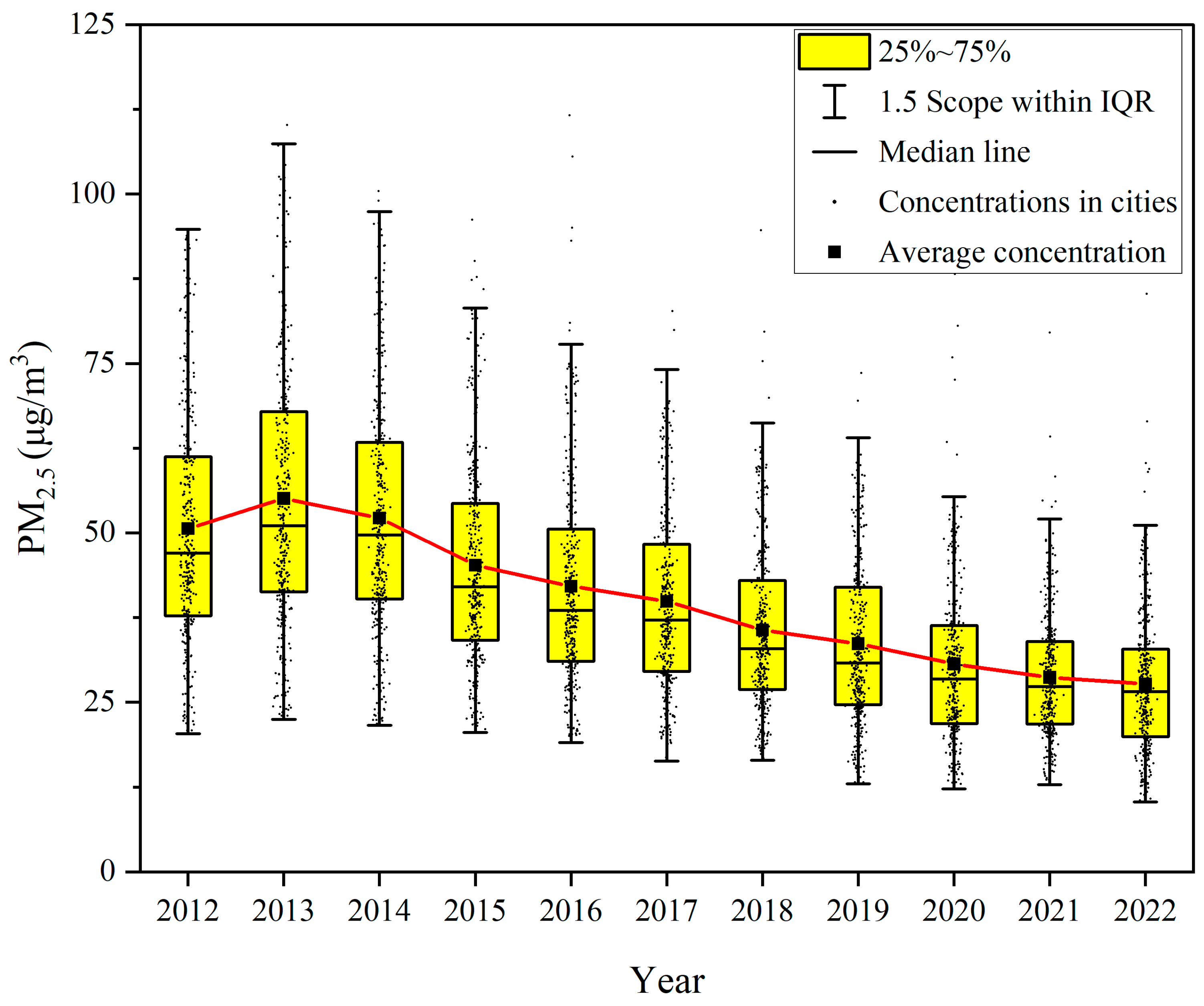
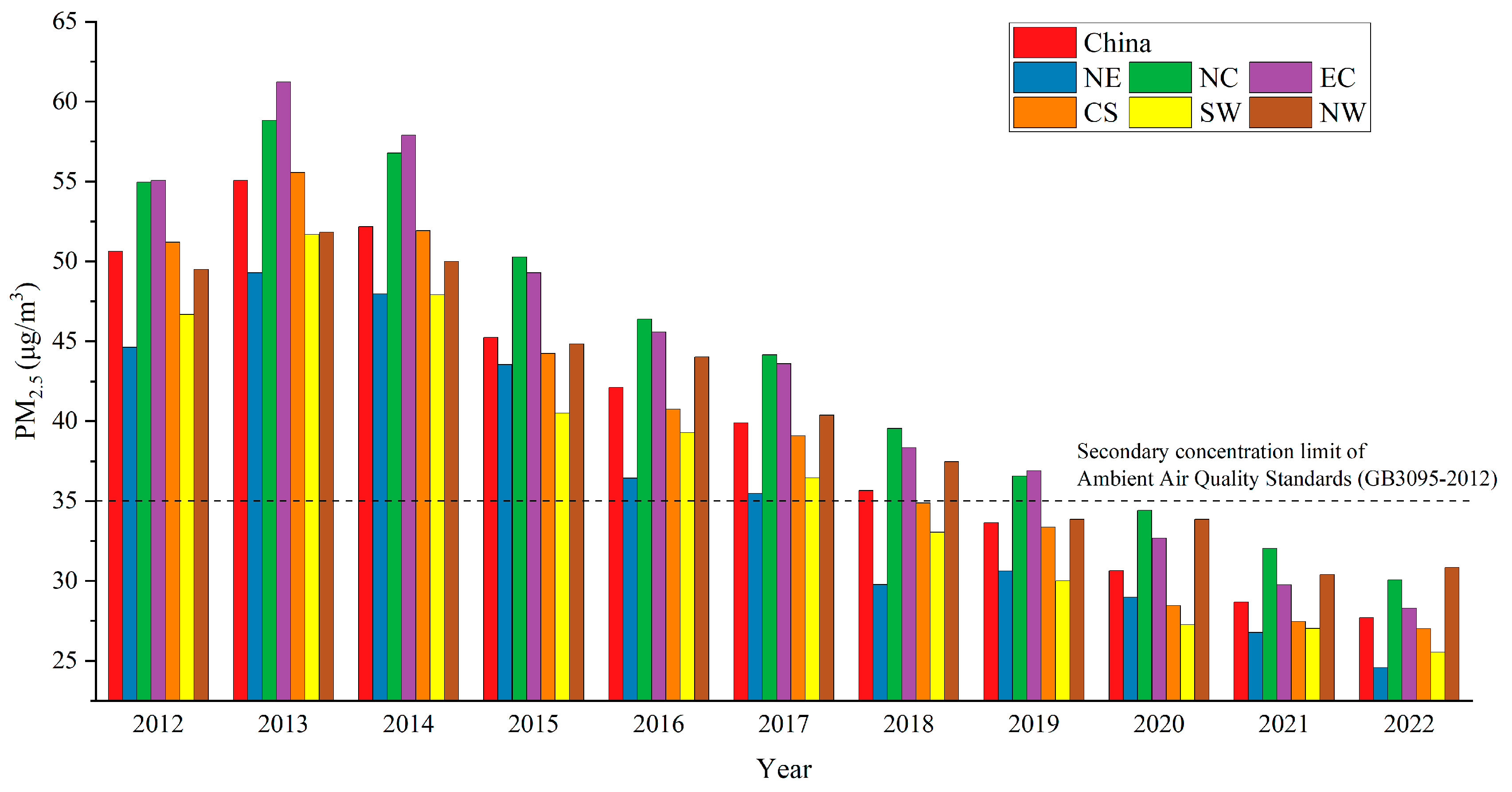

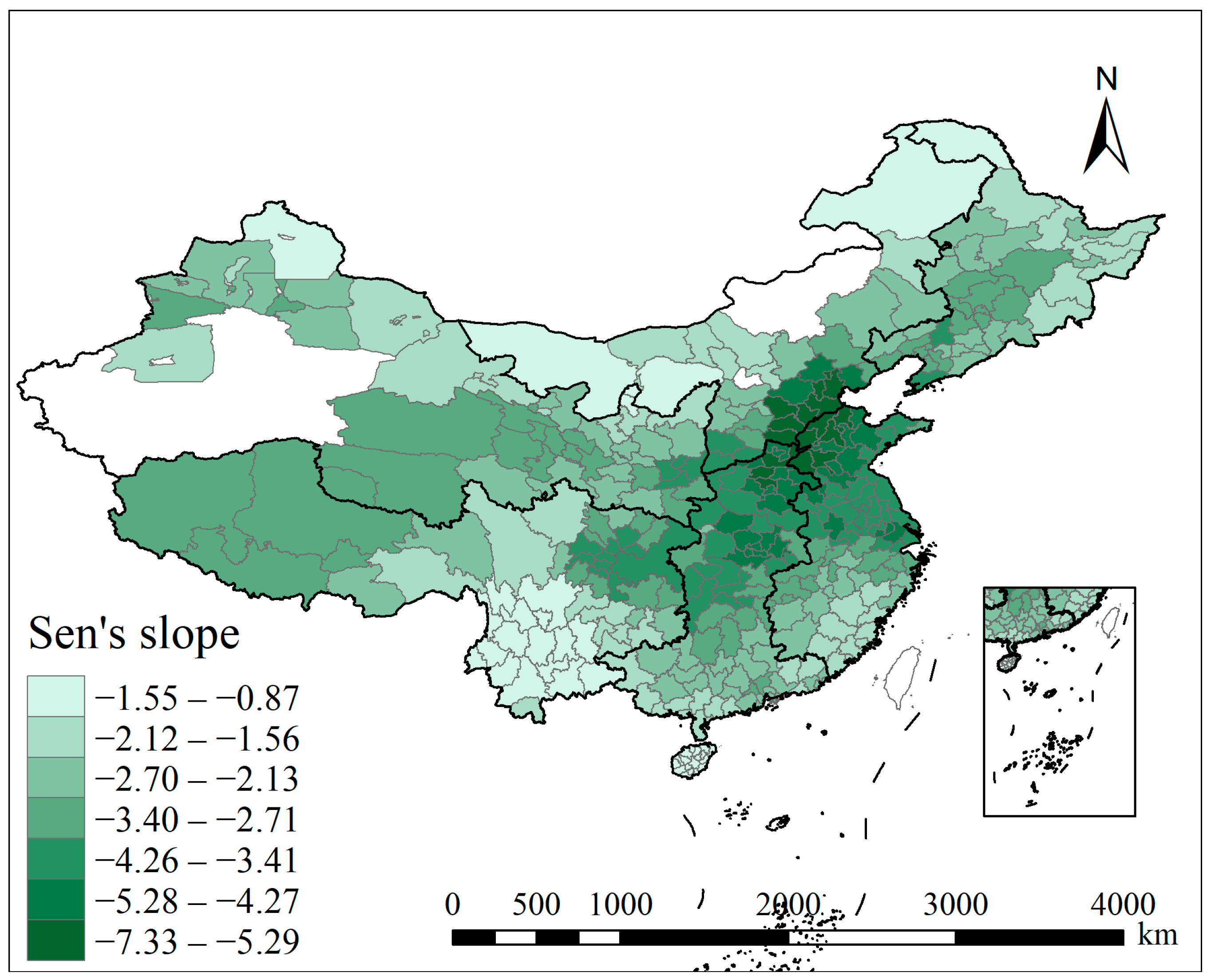
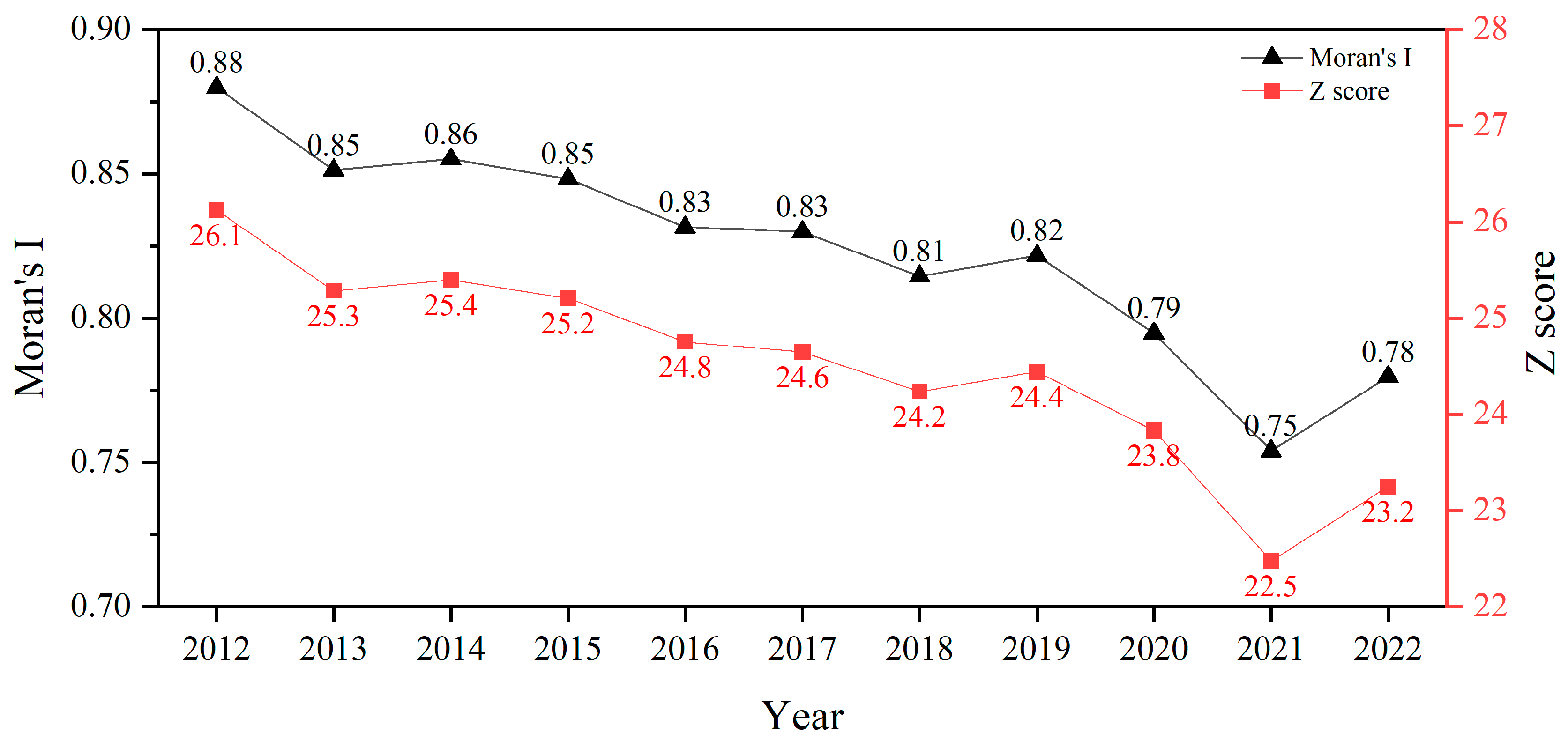

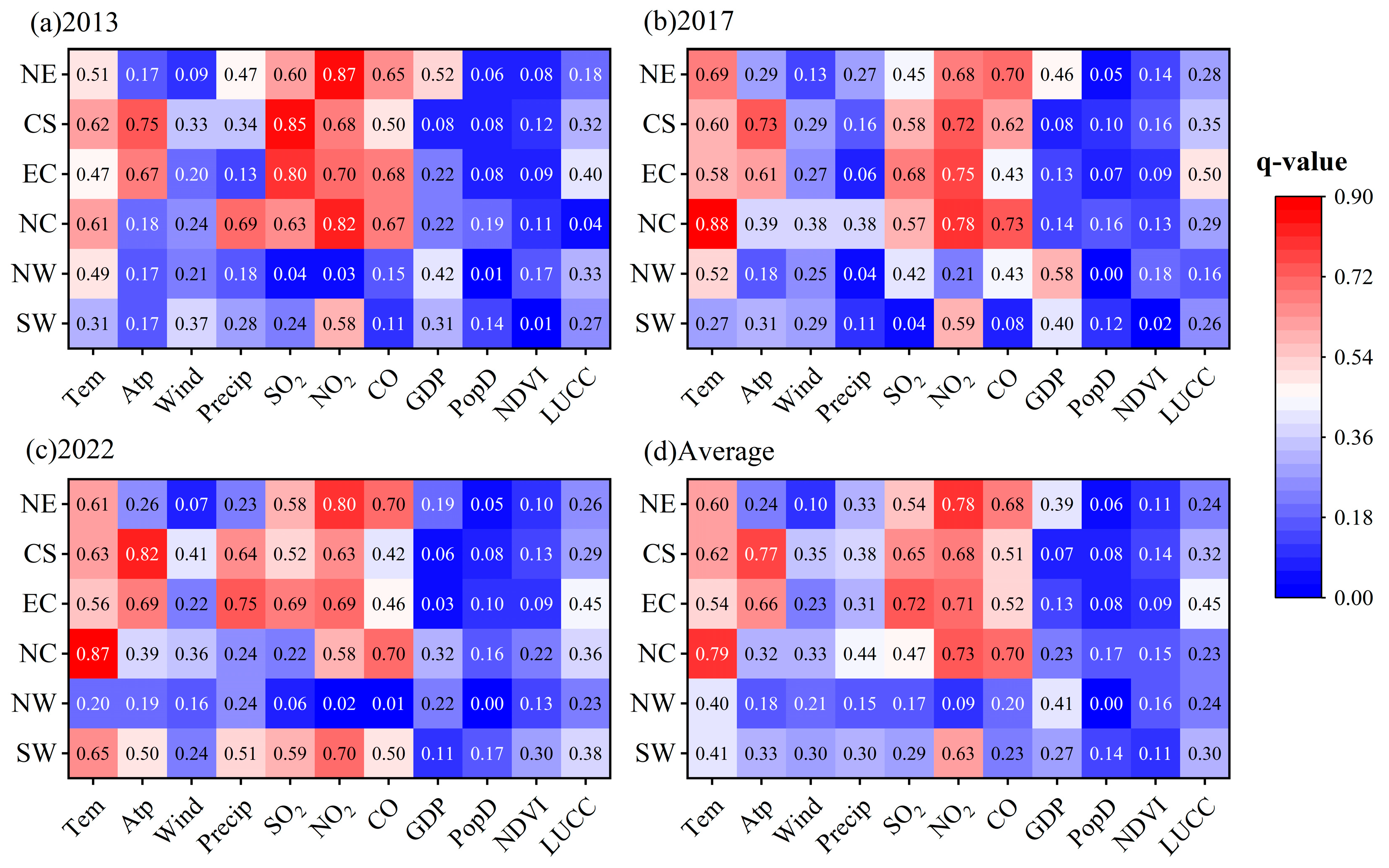

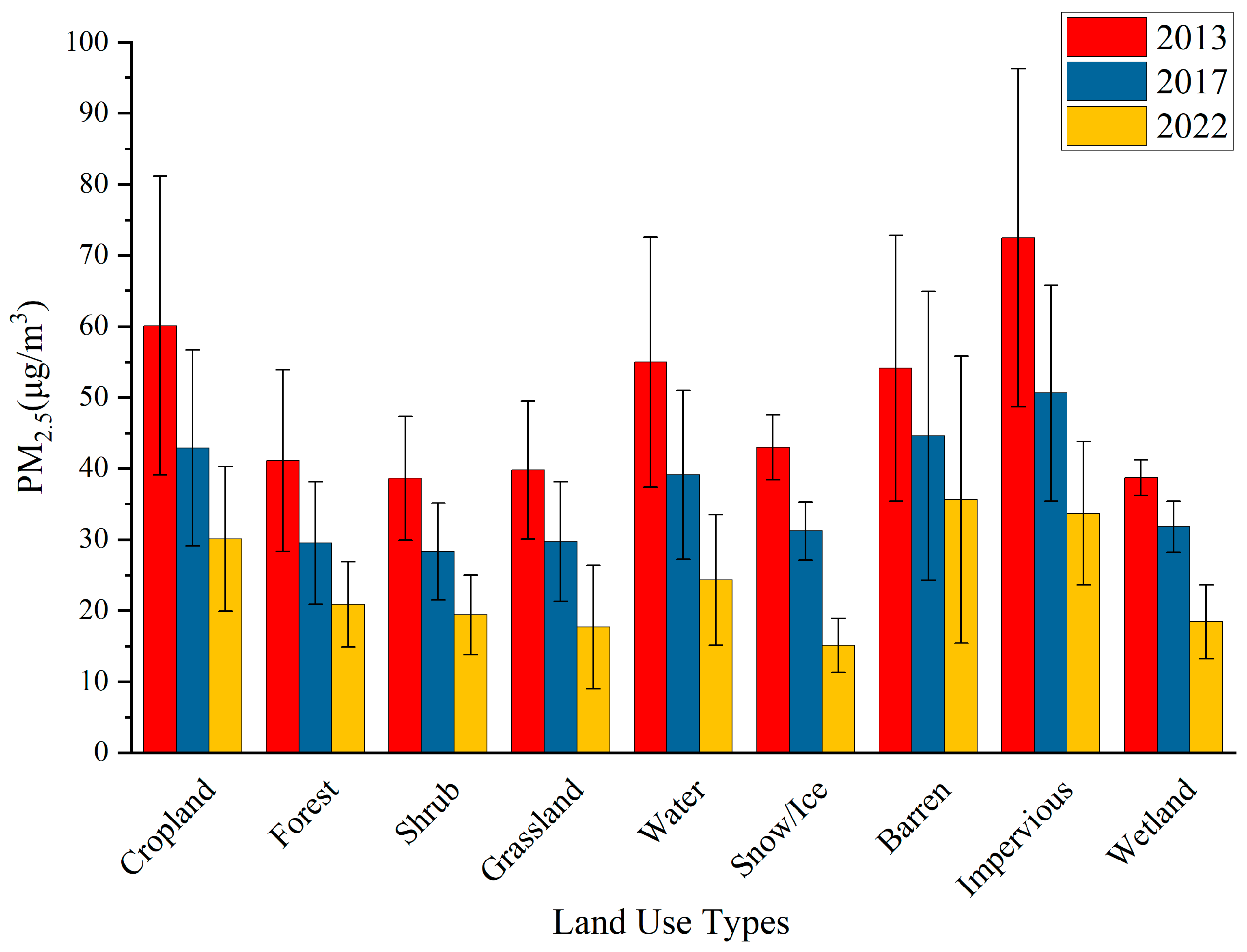
| Factors | edf | F | p-Value |
|---|---|---|---|
| s(Temperature) | 6.45 | 36.37 | <2 × 10−16 *** |
| s(Atmospheric Pressure) | 8.411 | 27.26 | <2 × 10−16 *** |
| s(Precipitation) | 8.114 | 21.64 | <2 × 10−16 *** |
| s(Wind Speed) | 5.481 | 10.94 | <2 × 10−16 *** |
| s(SO2) | 7.383 | 12.96 | <2 × 10−16 *** |
| s(NO2) | 2.846 | 66.7 | <2 × 10−16 *** |
| s(CO) | 1.69 | 91.01 | <2 × 10−16 *** |
| s(Log_GDP) | 3.312 | 5.23 | 0.000356 *** |
| s(Log_PopDensity) | 6.762 | 9.845 | <2 × 10−16 *** |
| s(NDVI) | 7.014 | 7.654 | <2 × 10−16 *** |
Disclaimer/Publisher’s Note: The statements, opinions and data contained in all publications are solely those of the individual author(s) and contributor(s) and not of MDPI and/or the editor(s). MDPI and/or the editor(s) disclaim responsibility for any injury to people or property resulting from any ideas, methods, instructions or products referred to in the content. |
© 2025 by the authors. Licensee MDPI, Basel, Switzerland. This article is an open access article distributed under the terms and conditions of the Creative Commons Attribution (CC BY) license (https://creativecommons.org/licenses/by/4.0/).
Share and Cite
Miao, Y.; Geng, C.; Ji, Y.; Wang, S.; Wang, L.; Yang, W. Understanding the Dynamics of PM2.5 Concentration Levels in China: A Comprehensive Study of Spatio-Temporal Patterns, Driving Factors, and Implications for Environmental Sustainability. Sustainability 2025, 17, 1742. https://doi.org/10.3390/su17041742
Miao Y, Geng C, Ji Y, Wang S, Wang L, Yang W. Understanding the Dynamics of PM2.5 Concentration Levels in China: A Comprehensive Study of Spatio-Temporal Patterns, Driving Factors, and Implications for Environmental Sustainability. Sustainability. 2025; 17(4):1742. https://doi.org/10.3390/su17041742
Chicago/Turabian StyleMiao, Yuanlu, Chunmei Geng, Yuanyuan Ji, Shengli Wang, Lijuan Wang, and Wen Yang. 2025. "Understanding the Dynamics of PM2.5 Concentration Levels in China: A Comprehensive Study of Spatio-Temporal Patterns, Driving Factors, and Implications for Environmental Sustainability" Sustainability 17, no. 4: 1742. https://doi.org/10.3390/su17041742
APA StyleMiao, Y., Geng, C., Ji, Y., Wang, S., Wang, L., & Yang, W. (2025). Understanding the Dynamics of PM2.5 Concentration Levels in China: A Comprehensive Study of Spatio-Temporal Patterns, Driving Factors, and Implications for Environmental Sustainability. Sustainability, 17(4), 1742. https://doi.org/10.3390/su17041742






